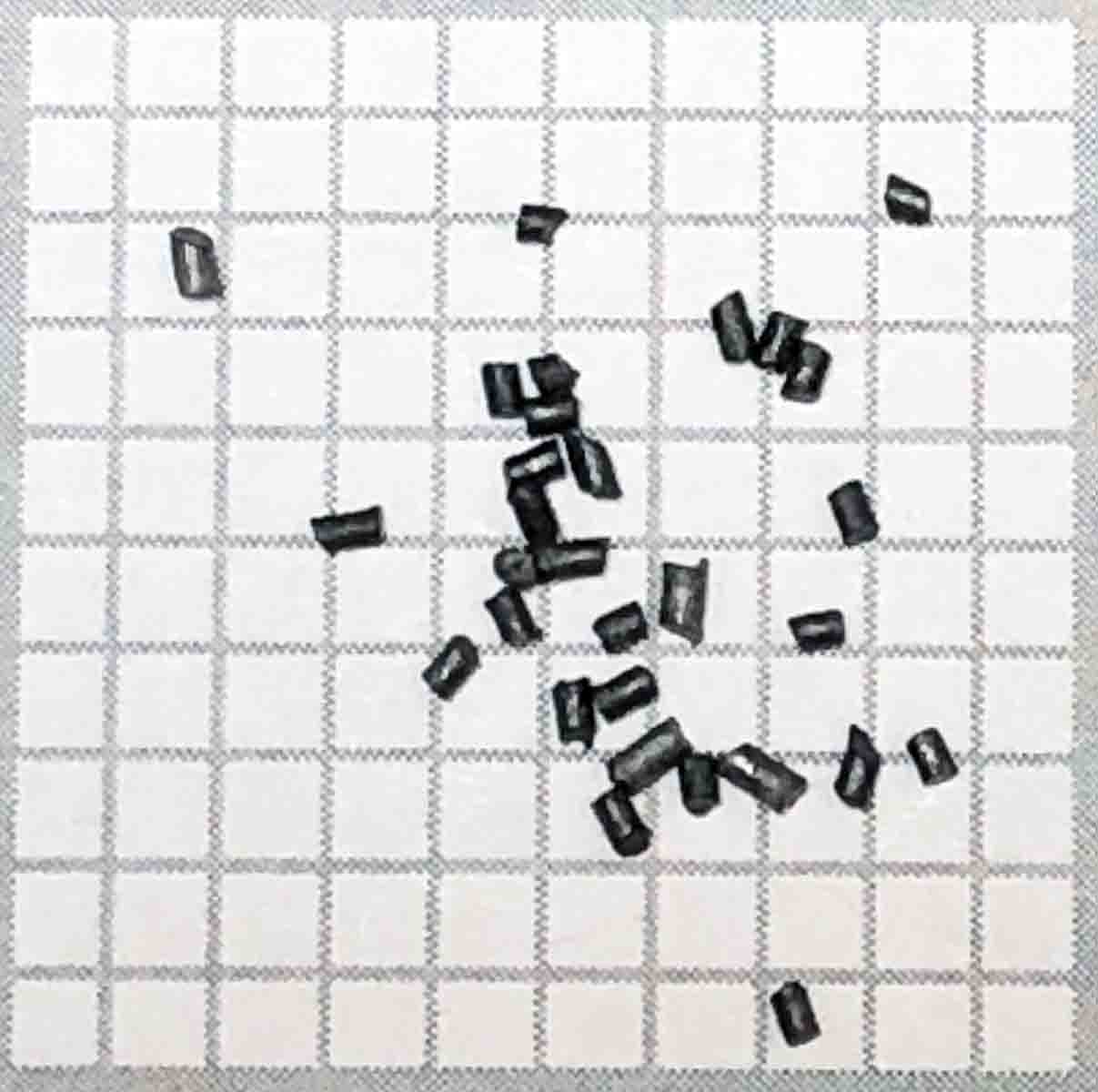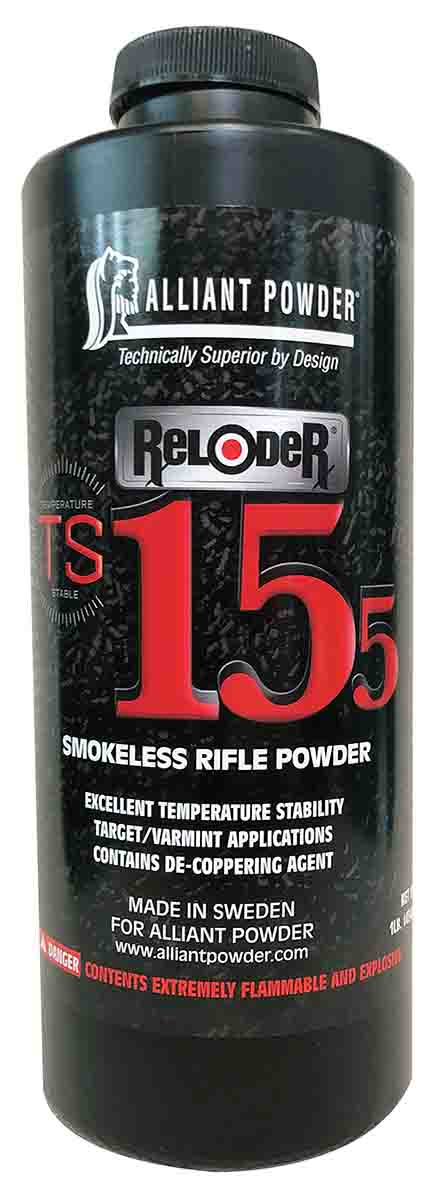Propellant Profiles
Alliant Reloder TS 15.5
column By: Randy Bimson | December, 21


Purchased by Alliant Techsystems Incorporated in 1995, the Hercules powders have been rebranded under the Alliant name. In addition to making many of the fine former Hercules brand powders available under the Alliant name, Alliant has made considerable investments in broadening its scope and depth to now include 17 rifle-specific powders.
I was an early adopter of the Reloder series of powders and found that Reloder 7, 11 and 12 became my go-to powders for a number of cartridges. More recently, in Rifle magazine’s Rifle’s Varmint Rifles & Cartridges, Fall 2021 special edition readers will find my article on a fine first-production run of the Ruger M77 Varmint in .220 Swift, where loads fueled by Reloder 15 repeatedly turned in the smallest groups.
Introduced in the spring of this year, Reloder TS 15.5 is the most recent addition to the Alliant line of propellants and its fourth entry, following Reloder 16, 23 and AR Comp, into the field of temperature-stabilized (TS) rifle propellants. For those not familiar with the term, temperature-stabilized propellants refer to propellants that feature technologies typically proprietary to the manufacturer, which generate more consistent pressures and velocities across a broad temperature range. In this instance, Alliant temperature-stable propellants utilize the proprietary TZ technology. It moderates the burn rate characteristics of the energetic material and resists the natural tendency to generate more pressure and correspondingly higher velocities at higher temperatures and less pressure and lower velocities at lower temperatures.
Many reloaders/shooters have come to appreciate these characteristics, which contribute to more uniform external ballistic data. More and more, temperature stable propellants are becoming the choice for loading ammunition for military mission-critical applications, long-range precision rifle series (PRS) matches and for many varmint hunting applications.
While the naming convention would suggest that TS 15.5 is a variant of Reloder 15, in fact TS 15.5 is a derivative of the technologies that brought us Reloder 16, Reloder 22 and AR Comp. Chemically, TS 15.5 is a double-base powder unique in comparison to many other double-base propellants in that it incorporates a very low percentage of nitroglycerin in its makeup. Two chemicals that previously have been common in the makeup of many propellant powders, dibutyl phthalate (DBP) and dinitrotoluene (DNT), as burn rate modifiers and plasticizers are absent in the chemical composition of TS 15.5. The move away from the use of these two chemicals is largely the result of the European Union (EU) REACH restrictions governing the manufacture and import of chemical substances and mixtures. Alliant TS 15.5 is compliant and can therefore be imported and sold in the EU countries. As mentioned earlier in this article, the proprietary TZ technology, a development of Bofors of Sweden, is a principal element used to achieve the superb temperature stability of TS 15.5. Alliant TS 15.5 also includes an increasingly more popular proprietary de-coppering element which greatly aids in maintaining barrel accuracy during a day’s shooting on a great prairie dog town or gopher patch and makes the barrel cleaning chore much less tedious.
The physical characteristics of TS 15.5 are very similar to Reloder 16. The extruded stick-like grains are a nominal .059 inch in length and .039 inch in diameter, with a perforation running from one end of the grain to the other. The grains are gray/black in color and the bulk density of TS 15.5 is 0.89g/cc.
The burn rate of TS 15.5 is right between Reloder 15 and Reloder 16 and very similar to Hodgdon’s temperature-insensitive propellant, Varget. This makes TS 15.5 potentially an excellent propellant for use with heavy-for-caliber bullets in the likes of the .223 Remington, 6mm and 6.5 Creedmoors and the .308 Winchester. This also makes TS 15.5 ideally suited for a broad spectrum of traditional hunting cartridges such as the .270 Winchester, .280 Remington and .30-06 Springfield, as well as a host of recently developed “performance” cartridges. My tests, well limited to 6mm Creedmoor and .308 Winchester, show TS 15.5 able to generate higher velocities for the same charge weight as Reloder 15 and the ability to load heavier charges at higher velocities still without pushing the pressure limits of my two test firearms.
The advantages of temperature- stable propellants have definitely got my attention. I have been fortunate to have hunted in parts of the world where it has been minus 40 degrees, which in either Fahrenheit or Celsius is darn cold, and to other parts where the daytime temperatures hit 105 degrees-plus Fahrenheit. Non-temperature stable powder like the classic IMR series can cause not only velocity and external ballistic changes but also related mechanical operational issues. On the ballistic side, the accepted rule for IMR-type powders has been for every one degree of temperature change, the velocity will change by 1 to 1.5 feet per second (fps). The combined effect of a temperature change from 70 degrees to minus 40 degrees, lowering the cartridge pressure and the denser cold air creating more drag on the bullet, can equate to well over a 110-fps drop in velocity. The pressure drop can also affect the mechanical function of gas-operated, self-loading rifles. To counter the pressure drop, some military rifles, like the Canadian C1 series FN-FAL rifle, which I am very familiar with, have an adjustable gas valve that allows the user to increase the gas flow to compensate for the cold-weather induced gas-port pressure drop.
I have also suffered the mechanical effects of high temperatures on loads which I considered conservative given my destination, increasing pressures to the point where it was not possible to operate a bolt-action rifle from the shoulder due to the bolt-lift being too difficult.
TS 15.5 and the rest of the temperature-stable family of propellants from Alliant address these issues. TS 15.5 is truly a very versatile powder. Combined with its ultra-temperature stable characteristic and a de-coppering agent and the very low extreme spread and standard deviations I experienced; I wholeheartedly recommend it in a handloader’s reloading powder inventory. TS 15.5 is available in 1-pound and 8-pound canisters.



.jpg)